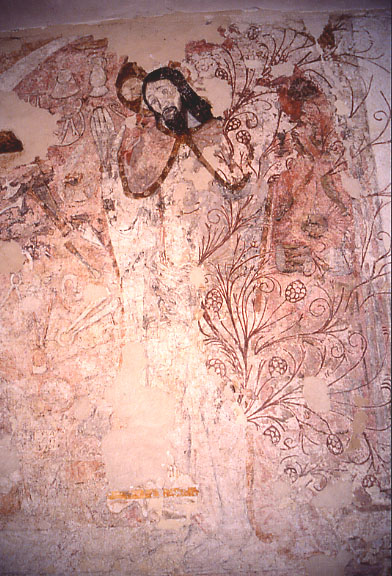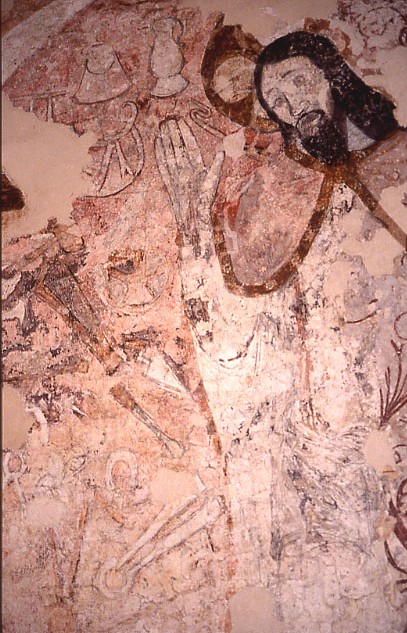Oaksey, Wiltshire (†Bristol) C.15
Warning to Sabbath Breakers

Christ stands just to the left of centre, his very black hair and beard probably largely a product of restoration. His hands are raised, palms outward, although only the right hand is visible now. Blood from its wound trickles down the wrist and forearm. Unusually, a cloak is draped around his shoulders – an elaborate affair with what is probably intended to be an embroidered border. It is likely to be the ‘gorgeous robe’ of Luke 23:11, since Sabbath breaking ‘set at nought’ and mocked Christ in much the same way that Herod and his men did. Christ’s sorrowful expression, although possibly somewhat overemphasised by restoration, might confirm this.
The surrounding implements are now confined to the left hand side, those on the right having disappeared under some very freely and fluently painted scrollwork foliage which cannot be much later in date. The very large ghostly leg and foot, with what looks like a narrow staff in yellow ochre to the right of it, must belong to another painting, perhaps of an earlier St Christopher, although there is a fine 15th version of the Saint (forthcoming) in the church.

The detail at the right shows the remains of Christ’s lobed halo, along with some of the implements. A jug is at the upper left, and a rod with a curved hook on the end projects from behind Christ’s shoulder. An object resembling a pouch to hang from a belt is further left, with another complicated, and, to me at least, unidentifiable one formed of curved and straight lines below it.
Moving downwards, something resembling a small, round-headed mallet has below it a wedge-shaped implement which might be a folded fan for winnowing grain from chaff. I cannot identify the object with a circular rim and something painted inside it, but it seems to be part of the design, and not an old consecration cross, as might appear. Below and beside this, showing white, is a small triangular shape with a handle, perhaps a pair of bellows, and then a chisel or router. A giant pair of tongs is beside Christ’s leg, with at least one horseshoe, and, at the extreme left, a small pair of pincers. Other objects have degenerated into meaningless detail, apart from an obvious axe-head and a probable scythe blade at the top far left (main picture).
In its original state, this must have been a painting with a great detal of emotional impact. Christ’s face and the expression on it are painted in a powerfully naturalistic way, which also suggests to me that the painting was made rather later in the 15th century than the date around 1400 given by Caiger-Smith.¹
Also at Oaksey is a badly damaged painting of St Edmund, and a St Christopher, complete with mermaid, is newly on this site.
¹ Caiger-Smith, p.180
† in page heading = Diocese